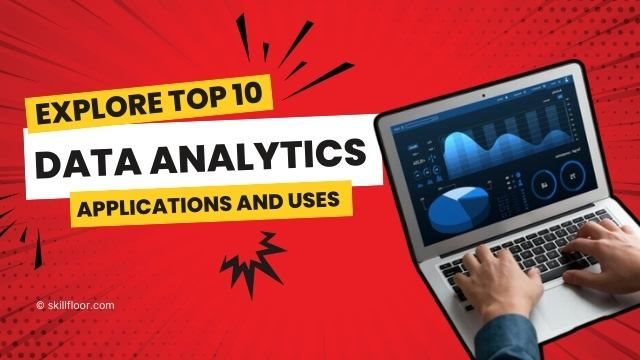Data Analytics for Long-Term Business Viability
The potential of data analytics for long-term business viability. Discover data-driven strategies, insights, and solutions to secure your company's future.

In today's fast-paced and ever-evolving business landscape, companies are constantly seeking ways to ensure their long-term viability and success. One of the most powerful tools at their disposal is data analytics. Data analytics isn't just about numbers and statistics; it's a strategic approach that empowers businesses to make informed decisions, predict trends, and create sustainable growth strategies. we'll explore the critical role of data analytics in securing long-term business viability.
Understanding Data Analytics
Data analytics involves the process of examining and interpreting data sets to draw meaningful insights and conclusions. This process encompasses several stages, including data collection, cleaning, transformation, analysis, and visualization. Through advanced techniques and tools, businesses can uncover patterns, trends, correlations, and outliers in their data.
Enhancing Decision-Making
In the realm of business, decision-making is the linchpin that determines an organization's trajectory. Gone are the days of relying solely on gut feelings or intuition to steer a company's course. Data analytics has ushered in a new era of decision-making, one that is rooted in empirical evidence and objective analysis. This approach empowers business leaders to make more informed and strategic choices that have a direct impact on long-term viability.
Data analytics provides decision-makers with a wealth of information to draw upon. By analyzing historical data, industry trends, market dynamics, and consumer behavior, businesses can uncover patterns and correlations that might have otherwise gone unnoticed. These insights transform decision-making from a subjective process to an objective exercise based on concrete evidence.
The beauty of data analytics lies in its ability to quantify uncertainties. It allows decision-makers to evaluate potential outcomes, risks, and opportunities with a degree of accuracy that was previously unattainable. This is especially crucial when considering long-term strategies, as the consequences of choices made today can ripple through an organization's future.
Predictive Insights
-
Anticipating Trends: Predictive insights involve analyzing historical data to identify patterns and trends that can help anticipate future developments in various aspects of business, such as market demand, consumer behavior, and technology shifts.
-
Data Mining Techniques: Data mining techniques, such as regression analysis, time series analysis, and machine learning algorithms, are used to uncover hidden relationships and patterns in the data that can be used to make predictions about future outcomes.
-
Customer Behavior Prediction: Predictive insights enable businesses to understand how customers are likely to behave in the future. This includes predicting purchasing patterns, preferences, and potential churn, which aids in tailoring marketing strategies and customer engagement.
-
Risk Assessment: Predictive analytics helps assess and manage risks by identifying potential threats before they occur. Businesses can predict factors such as credit default, fraudulent activities, and supply chain disruptions, allowing them to take proactive measures.
Customer-Centric Approaches
A customer-centric approach revolves around understanding, anticipating, and fulfilling customer needs and expectations. Instead of solely concentrating on pushing products or services, businesses adopting this approach emphasize building strong relationships with their customers. This involves actively listening to customer feedback, monitoring buying behavior, and consistently tailoring offerings to suit individual preferences.
Key Aspects of Customer-Centric Approaches:
-
Personalization: Customer-centric companies strive to deliver personalized experiences. By analyzing customer data and behavior, businesses can customize their offerings, marketing messages, and interactions, making customers feel valued and understood.
-
Customer Journey Mapping: Understanding the customer journey—each touchpoint a customer has with a brand—helps identify pain points and opportunities for improvement. This enables companies to create a seamless and satisfying experience at every stage.
-
Feedback and Listening: Engaging with customers and actively seeking their feedback is crucial. Customer opinions provide valuable insights that can drive product improvements, service enhancements, and process optimizations.
-
Omnichannel Approach: Customer-centricity extends across various channels, including physical stores, websites, social media, and more. Consistency in communication and experience enhances customer trust and loyalty.
Operational Efficiency
Operational efficiency is the bedrock upon which successful businesses are built. It refers to the ability of an organization to optimize its processes, resources, and workflows to achieve maximum output while minimizing waste and costs. In a rapidly changing business environment, operational efficiency is not just a luxury but a necessity for long-term sustainability.
At its core, operational efficiency involves identifying bottlenecks, redundancies, and inefficiencies in various aspects of business operations. This could include production processes, supply chains, inventory management, customer service, and more. By carefully analyzing these areas, businesses can uncover opportunities to streamline workflows, eliminate unnecessary steps, and allocate resources more effectively.
The benefits of operational efficiency are multifaceted. Firstly, it leads to cost savings. When processes are optimized, companies can reduce wastage of resources, time, and effort. This not only directly impacts the bottom line but also enhances overall profitability. Secondly, operational efficiency enhances productivity. By removing obstacles and optimizing processes, employees can work more effectively, completing tasks in less time and with fewer errors.
Risk Management
Risk, in a business context, refers to the possibility of an event occurring that could have adverse effects on the achievement of goals or objectives. These events can vary widely, encompassing everything from financial market fluctuations and regulatory changes to natural disasters and technological failures. While not all risks are negative – some can lead to unexpected gains – the focus of risk management is primarily on minimizing potential negative impacts.
Key Components of Risk Management:
-
Risk Identification: The first step in risk management involves identifying potential risks that could affect the organization. This requires a comprehensive analysis of the internal and external factors that may impact business operations, goals, and objectives.
-
Risk Assessment: Once risks are identified, they need to be assessed in terms of their likelihood of occurrence and potential impact. This assessment helps prioritize which risks are most critical and require immediate attention.
-
Risk Mitigation: Mitigation involves developing strategies and actions to minimize the potential negative impacts of identified risks. This could involve implementing safeguards, contingency plans, or diversification strategies to reduce the likelihood and severity of risk events.
Innovation and Adaptation
In the dynamic business landscape of today, innovation and adaptation are twin forces that businesses must harness to thrive. Innovation involves the creative spark that leads to novel ideas, improved processes, and game-changing products. It's about staying ahead of the curve by daring to challenge norms. On the other hand, adaptation is the art of staying flexible and responsive to external shifts. It's about embracing change with agility, reimagining strategies, and optimizing operations to remain relevant.
These concepts coexist synergistically, with innovation inspiring new directions and adaptation ensuring resilience in the face of evolving challenges. This interplay empowers businesses not only to envision a better future but also to navigate the present with confidence.
Building a Data-Driven Culture
Valuing Data
The first step in building a data-driven culture is recognizing the intrinsic value of data. Data is not just a byproduct of operations; it's a strategic asset that can provide insights into customer behavior, market trends, operational efficiency, and more. When employees understand and appreciate the significance of data, they are more likely to embrace data-driven practices.
Leadership Buy-In
Creating a data-driven culture requires strong support from leadership. When top-level executives champion the use of data in decision-making, it sends a clear message throughout the organization that data is a priority. Leaders should lead by example by incorporating data-driven insights into their own decision-making processes.
Education and Training
Not everyone within the organization might be comfortable with data analysis or interpretation. Providing employees with the necessary education and training to understand and utilize data effectively is crucial. This can involve workshops, seminars, online courses, and even hiring data specialists who can guide and mentor others.
In an era where change is constant and competition is fierce, data analytics emerges as a powerful ally for ensuring long-term business viability. From informed decision-making and predictive insights to customer-centric approaches and operational efficiency, data analytics touches every aspect of a company's operations. By embracing data-driven strategies, businesses can position themselves for sustained growth, innovation, and success in the dynamic landscape of the future. Remember, the insights hidden within your data could be the key to unlocking a brighter and more viable future for your business.






























































